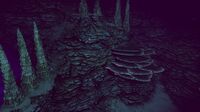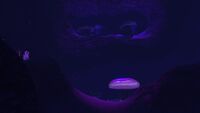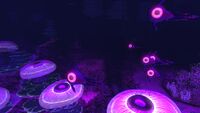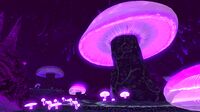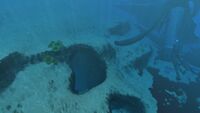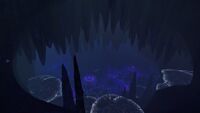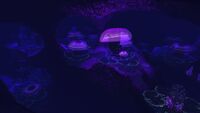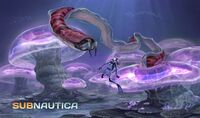Jellyshroom Cave
<infobox layout="stacked">
<title source="title1"> <default>Jellyshroom Cave</default> </title> <image source="image1">
</image> <label>Tab</label> <label>Type</label> <label>Biome</label> <label>Depth Range</label> <label>Temperature Range</label> <label>Biome ID</label> <label>Harvesting Nodes</label> <label>goto ID</label> <label>Coordinates</label> <label>Base ID</label> <group> <label>Point of Interest</label> <label>Music</label> </group> </infobox>
The conditions in this cave may support a microcosm of unique, possibly predatory lifeforms. Try to counter unanticipated threats by anticipating them.
― PDA, Dialogue
The Jelly Shroom Caves is a large cave system found deep below the Grassy Plateaus, Kelp Forest, and Safe Shallows. The entrances to this area are usually found as honeycomb crevices on the seabed.
Description
The Jelly Shroom Caves are characterized by a dense population of huge translucent, purple Jellyshrooms, along with cavern structures, such as stalactites and stalagmites.
The cave system has two predatorial species, and two passive species. The most notable of these are the Crabsnakes residing in Jellyshrooms, and the Oculus, both of which are found only in this biome.
As the Jelly Shroom Caves can only be accessed from above by small openings in the ground, it is completely inaccessible to the Cyclops, and a Prawn Suit may have difficulty boosting high enough to get out.
An abandoned seabase built by the survivors of the Degasi can also be found in the Jelly Shroom Caves. <tabber> Resources=
- Gold
- Lithium
- Magnetite
- Silver Ore
- Diamond
- Crabsnake Egg
- Gel Sack Spore
- Cave Bush Seed
- Violet Beau Seed
- Jellyshroom Spore
- Redwort Seed
- Furled Papyrus Seed
- Rouge Cradle Seed
|-| Fauna=
|-| Flora=
</tabber>
Gallery
<tabber> In Game Screenshots=
Oculus swimming in the Jelly Shroom Caves
Jellyshrooms and their smaller variants
An entrance to the cave system from the Grassy Plateaus
|-| Concept Art=
</tabber> For a more complete gallery, visit Jelly Shroom Caves/Gallery.
Trivia
- The abundance of Stalactites suggests that these caverns were dry-standing for several million years, only later being flooded presumably when the ceiling collapsed due to erosion - this might explain why its native ecosystem is so uniquely different from all bordering biomes.
Lua error in package.lua at line 80: module 'Dev:Navbox' not found.


